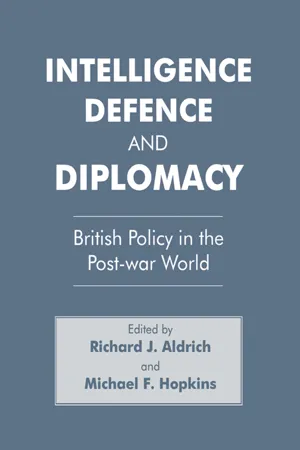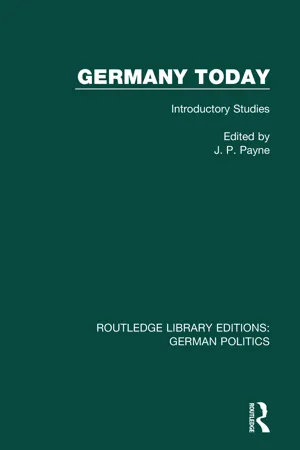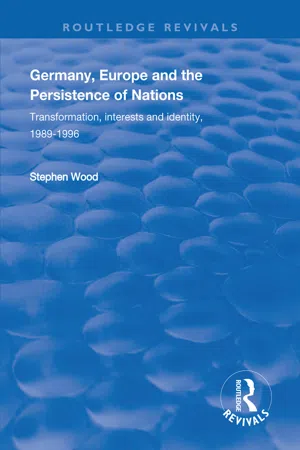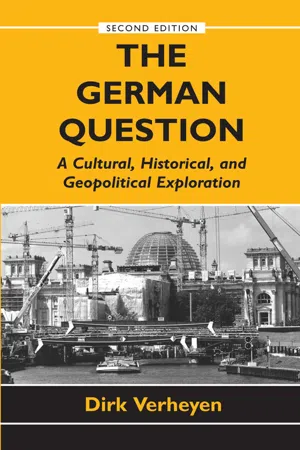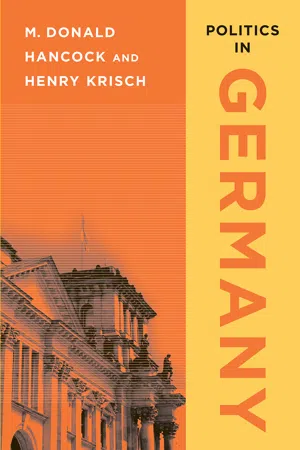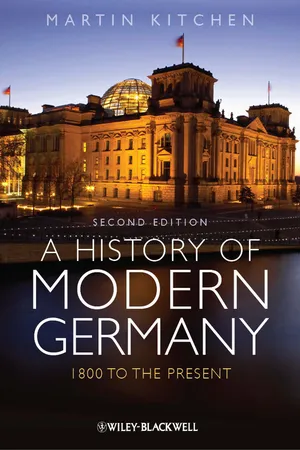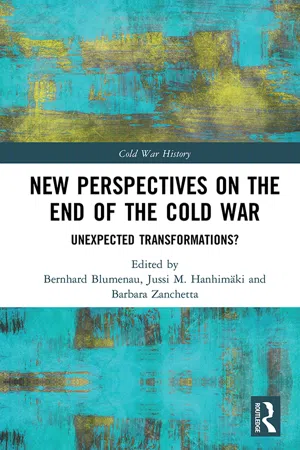History
German Reunification
German Reunification refers to the process by which East and West Germany were reunified as a single nation in 1990, following the fall of the Berlin Wall in 1989. This historic event marked the end of the Cold War division in Europe and led to the establishment of a unified Germany with a single government, economy, and legal system.
Written by Perlego with AI-assistance
Related key terms
Related key terms
1 of 4
Related key terms
1 of 3
10 Key excerpts on "German Reunification"
- eBook - ePub
Intelligence, Defence and Diplomacy
British Policy in the Post-War World
- Richard J. Aldrich, Michael F. Hopkins(Authors)
- 2013(Publication Date)
- Routledge(Publisher)
3 Reunification or Integration with the West? Britain and the Federal Republic of Germany in the early 1950s Klaus LarresDOI: 10.4324/9781315035925-3The period between the fall of the Berlin Wall in November 1989 and the merging of East and West Germany on 3 October 1990 was marked by worries and the concern of many people that a unification of the two Germanies would destabilize Europe.1 It was alleged that a united Germany with a population of almost 80 million would soon become a new economic superpower and once again an arrogant political giant on the international scene.2 Only very few people believed that the four victorious powers of the Second World War were genuine and unequivocal supporters of the creation of a unified German state. However, developments in Eastern Europe in 1989–90 seemed to make German unification inevitable. Britain, France, the United States and the Soviet Union now had to stand by their many promises to the German people during the previous 45 years and convert these pledges into reality.In the 1950s, when the international scene was still very fluid and the modus vivendi of the Cold War not yet fully accepted, politicians in East and West also kept professing that they were seriously interested in overcoming the partition of Germany as soon as possible.3 Why, then, did it never materialize? After all, politicians and the military in the early 1950s genuinely believed that a permanent division of Germany would soon lead to turmoil and war. Based on the convictions as expressed at the Potsdam Conference in 1945, they thought that only a united Germany would guarantee a peaceful and economically healthy Europe. Otherwise it was assumed the German people would soon create so much trouble in order to obtain unity and prosperity that the stability of Europe and the world would be seriously endangered.4 This attitude began to change with the gradual Western realization that not only Chancellor Adenauer but above all the West German people, the huge majority of the German population, were not really very much interested in getting the country reunified. Despite the popularity of the unification issue in opinion polls and ‘the simmering discontent with the division of Germany’,5 the West Germans were apparently much more concerned with rebuilding their own careers and enjoying the fruits of the burgeoning economic miracle than with the fate of their brethren in the East. The High Commissioner in Bonn even claimed that the Germans were mainly interested in the ‘three Bs’ – belly, BMW and building society account.6 - eBook - ePub
Germany's Russia problem
The struggle for balance in Europe
- John Lough, Andrew Monaghan(Authors)
- 2021(Publication Date)
- Manchester University Press(Publisher)
3The miracle of reunification
The extraordinary achievement of German Reunification in 1990 merits a separate discussion because of its continuing impact on German thinking about Russia. The dramatic events of 1989–90 offered hope to Germans who had been on the front line of the Cold War of a new peaceful era in a unified country in an undivided Europe. Gorbachev’s acquiescence to reunification and post-Soviet Russia’s acceptance of it pointed to an era of stability and harmony in Germany’s relations with Russia, and an unprecedented opportunity for Germany to feel at peace with itself. This in turn encouraged a sense of deep gratitude to Moscow for making such an unexpected outcome possible. Yet the neat conclusion of the Cold War with its quixotic vision of an all-European cooperative security framework stretching from Lisbon to Vladivostok was only a flicker before the sobering realities of the break-up of Yugoslavia and the disintegration of the USSR intruded. Three decades later, there is still nostalgia in Germany for this seductive moment when it finally seemed possible to square the circle and for the country to be fully reconciled with both its western and eastern neighbourhoods.Coincidence of favourable factorsThe reunification experience is also a reference point today for those arguing that Germany and its allies need to defuse the current confrontational relationship with Russia by re-enacting the policies that helped end the Cold War.1 Again, this reflects a tendency to oversimplify and ignore the larger picture. For German Reunification to take place peacefully at such speed required a remarkable coincidence of events, beginning with Moscow’s decision to move away from confrontation with the West and view the FRG as its most promising western partner, a move that inadvertently destabilised the GDR. Statesman-like leadership on the part of the main actors also played a major role in containing the process that briefly ran out of control when the Berlin Wall unexpectedly opened. There was considerable improvisation under pressure since Bonn did not have a master plan for reunification. The FRG’s operational planning for reunification had stopped in 1960.2 Fortunately, Helmut Kohl, George Bush and Mikhail Gorbachev together proved equal to the task. The process could easily have gone wrong in several ways: conservative forces could have ousted Gorbachev earlier; the East German authorities could have deployed force to disperse demonstrations. Thankfully, the protests remained peaceful, in large measure due to the influence of the Protestant church.3 - eBook - ePub
- David Armstrong, Erik Goldstein(Authors)
- 2013(Publication Date)
- Routledge(Publisher)
The Re-emergence of ‘the German Question’: a United Germany and European Security and StabilityIEUAN G. JOHNThe sudden, dramatic and accelerating process of revolutionary change in Eastern Europe during winter 1989/90 and early 1990 has begun to erode the foundations of the Europe of Yalta. In particular the liberation of the East Germans from the repressive and stifling Honeker regime in the German Democratic Republic (GDR) has moved the issue of German Reunification from the back-burner of history to the top of the contemporary European political agenda. The ‘German question’, in the last quarter of the nineteenth century and the first half of the twentieth the central issue of European diplomacy and strategy, has re-emerged albeit in a new European and global setting. I propose first to identify the main determinants of the German ‘problem’; second, to describe and analyse briefly the role of a divided Germany in the bipolar balance of power in Europe through the alternating phases of acute tension which characterised the ‘cold war’ and relaxation of tension (the more precise meaning of the term détente); third, to trace and examine the relations between the Federal Republic of Germany (FRG) and the German Democratic Republic (GDR) before and after the popular movement of revolt sparked off by the exodus of East Germans to West Germany and assess the pace and scope of process of unification, and last to consider the implications for and consequences of the unification of the two Germanies for the future European order.From a modern historical perspective, the ‘German question’ stems from three factors. Two of them could be described as perhaps objective factors: Germany’s geographical location in the very centre of Europe with all its diplomatic and strategic consequences and the relative size, in comparison with its neighbours and other European states, of its territory, population, human and material resources and potential as well as actually deployed military power. The third element is the political psychology, culture and behaviour of its ruling elites who have been charged not only by foreign but also by some German historians and political scientists with lack of a sense of proportion and realism and a tendency to pursue unlimited goals. Germans have been characterized and perceived as unstable, restless and obsessed with an acute and morbid anxiety (angst) bordering at times on hysteria.1 Whatever truth there is in these observations and assessments, combined with the fact of Germany’s geopolitical location, they have had and still continue to have an influence on other countries’ attitudes to the question of Germany’s future role in Europe. In the words of a distinguished American scholar, ‘because of its geography Germany’s instability was an immediate threat to Europe. Modern Germany was born encircled.’2 - eBook - ePub
Germany Today (RLE: German Politics)
Introductory Studies
- John P. Payne(Author)
- 2014(Publication Date)
- Routledge(Publisher)
1 Germany and Reunification R. CECILHistory is not just what happened; it is also — and perhaps more significantly — what people have come to believe happened. This can be illustrated by two episodes separated in time by ten years. The first took place in the spring of 1959 near the zonal border between the German Federal Republic (GFR) and the 'so-called' German Democratic Republic (GDR). I was looking across the barbed-wire and the ploughed strip at some cherry trees in flower, when a middle-aged German farmer came up to me and remarked that, until the wire went up, those trees had belonged to him. I was on the point of expressing my sympathy, when he added, 'That's what your Churchill, Roosevelt and Stalin did to me!' Instead of the words of sympathy, I felt obliged to ask whether Hitler had not also had something to do with it. This put an abrupt end to the conversation.The second episode took place in Bad Godesberg during the federal election campaign of September 1969. Giinter Grass was addressing a packed meeting, at which an unusually high proportion of young people was present. Whenever foreign policy was mentioned, an elderly man persisted in shouting, 'What about Koenigsberg?' (This famous East Prussian city has now been incorporated in the USSR.) Finally Grass turned to him. 'Koenigsberg', he said, 'was gambled away through German folly and you will have to get used to it.' This reply evoked no murmurs of discontent, but rather a round of applause.Various interpretations could, of course, be placed on these stories. They could be taken to illustrate the generation gap, the growing political sophistication of the German people, or the simple fact that time is the great healer. But does this mean that the issue of reunification is gradually being forgotten and that Germans are becoming content to live divided? He would be a bold man who would defend this thesis, even though Deutschlandpolitik was not a major issue in the 1969 election campaign. Outside Germany, there is indeed a trend in the direction of 'letting sleeping dogs lie'. It is a comparatively recent development. In i960 Anthony Nutting wrote in International Affairs, 1 - eBook - ePub
Germany, Europe and the Persistence of Nations
Transformation, Interests and Identity, 1989-1996
- Stephen Wood(Author)
- 2018(Publication Date)
- Routledge(Publisher)
45The success of this operation made the Federal Republic appear much like a unitary state, at least in the concentration of power and evidently pluralist interests assembled and enacted so effectively. It provided a 'shining example of the possibilities for political leadership of a 'co-ordination democracy' under less than easy conditions', and one 'due to the overriding importance of the theme of German Reunification'. There were protestations against a takeover and hegemony of the west. Before long a 'wall in the head' separating east and west Germans and nostalgia for both 'old systems' appeared. However, when circumstances had most required the national dynamic, or the idea of the nation, was the determining political force. GEMSU showed that the Bundesbank was not completely autonomous. Doubts about unity on 'rational' economic-financial grounds were overwhelmed by politics; enacted in a national interest of moral-constitutional, emotive, historical, geo-strategic and cultural components. Glees argues that 'There is no real evidence that Germany is a 'post-national' state, nor any evidence that such a thing exists or could ever exist. German Reunification was a clear expression of German nationalism. No serious German politician could hope to win power by seeking to rubbish nationalism, nor would they be believed, either at home or abroad, if they did so.' Although this should be modified to state that none could win power by denigrating the German nation (rather than nationalism), Glees accurately notes that in the period since, 'an element of residual submissiveness towards the international community' is not 'post-nationalism', 'but simply a current definition of Germany's national interest'.46 - eBook - ePub
- Dirk Verheyen(Author)
- 2018(Publication Date)
- Routledge(Publisher)
33 Jewish concerns frequently persisted, however, in part because no explicit all-German admission of guilt for the Holocaust was included in the final FRG-GDR unification treaty. The likelihood of claims made against a reunited Germany by Jews and others also continued to loom as a source of very probable controversy, as events in the 1990s have indeed confirmed.As Christoph Bertram pointed out, the basic international agenda resulting from the inexorable drift toward German Reunification involved “the security status of Germany, the cancellation of the remnants of Germany’s now obsolete postwar legal regime, the special rights of the Four Powers, the status of the city of Berlin, and the finalization of Germany’s external borders, particularly with Poland.” In addition, the European Community would have to “define the modalities of permitting one of its member states to be enlarged.”34The exact ways in which this agenda would be managed, and the various issues settled, could only become clearer as the months and weeks passed, and some aspects might not be fully settled for at least several years after formal FRG-GDR unification. What became very obvious, however, was that this agenda reflected the basic dimensions of an enduring German Question with which Germans and non-Germans alike had to contend. It was clear that one aspect of that Question, namely national unity , was at least formally “solved,” although lingering revisionism due to the loss of former Eastern territories might have to be watched carefully.But it was also important to remember that territorial and legal German unification by itself did not by any means result in immediate, genuine East-West German cultural and psychological unity. Forty years of political-ideological and psychological separation could not and would not be undone overnight. What is more, the dismal economic picture in the former GDR all but guaranteed that the population in “East” Germany would for some years to come have to cope with a (perceived as well as real) status as “second-class” citizens in the new Germany, frequently subject to “West” German disdain, ridicule, and resentment.35 In fact, Michael Meyer suggested that “[t]he German Question has… been reincarnated, in a new form,” because “[t]he new Germany will be one nation, but two peoples.”36 Interesting in this context of continued “disunity” was also the discussion of what the “eastern” part of the new Germany ought to be called in political discourse: “the former GDR,” “the new Federal Länder ,” “eastern Germany”? For many conservatives who continued to harbor revisionist dreams regarding the lost “eastern” territories in Poland and the Soviet Union, of course, the former GDR would always remain Mitteldeutschland. 37 - eBook - ePub
- M. Donald Hancock, Henry Krisch(Authors)
- 2008(Publication Date)
- CQ Press(Publisher)
3Germany Divided and Unified
G erman politics during the twentieth century was dominated to an unusual extent by history and Germans’ reactions to that history. The half century of Germany’s foreign occupation, division, and unification forms the immediate chronological background to the contemporary scene. For more than forty years, German politics were shaped by powerful external forces of foreign occupation and alliances and by an intense inter-German competition between the two German states created in the war’s aftermath. The end of the Cold War signaled an end to this postwar phase of German history. In the following chapters, we explore the problems and prospects of German politics, domestic and foreign, now and in the near future. Here, we first review the course of German division and the country’s unification.During the Cold War era of German history (1945–1990), three themes dominated politics in both East and West Germany: the future of the German national state, German national identity in its historical context, and the impact on German politics of the international environment. German politics also was animated by contentious domestic social and economic issues. Indeed, the two German states developed starkly contrasting socioeconomic systems. From the perspective of the unified Germany of the twenty-first century, however, with its dominant West German political and economic systems, that economic and social competition is important for the part it played in forming German identity.The Germans dealt with these issues in the framework of two rival states, each linked to a major Cold War bloc. This “cold civil war” on German territory ended with the collapse of the East German state in 1989, the acquiescence of the Soviet Union to German unification within the Western alliance a year later, and the unification of Germany as the Federal Republic of Germany. This proved to be a struggle between two uneven partners. The victorious western Federal Republic was larger, more populous, better endowed with natural resources, and linked to the economically and militarily more powerful ally. Thus the resolution of Germany’s problems in the Cold War historical era has led to a united Germany that must cope with a difficult dual heritage (Nazi and communist), as well as with the task of integrating a poorer, smaller, defeated region into the modern German polity.1 - eBook - ePub
Rereading German History (Routledge Revivals)
From Unification to Reunification 1800-1996
- Richard J. Evans(Author)
- 2015(Publication Date)
- Routledge(Publisher)
The reunification of Germany in 1989/90 caught almost everyone on the intellectual scene in the Federal Republic by surprise. On the left, Germany's division had long been regarded as part of the price paid for the crimes of Nazism, and advocates of reunification as dangerous reactionaries who harked back to the days of the Bismarckian Empire if not the pan-Germanism of the Third Reich. Communist East Germany was depicted in neutral, even to some extent favourable, terms, often simply as a different kind of democracy, rather than a tyranny that had to be overthrown, or a part of Germany wrongfully under foreign occupation. Militant anti-Communism of the sort which became commonplace in the United States once more under the Reagan presidency appeared threatening because any serious attempt to conquer East Germany by force would inevitably lead to a war on German soil, with massive devastation caused by the use of tactical nuclear weapons. On the whole, therefore, reunification was opposed on the West German left because it raised old ghosts of German history and conjured up the nightmare of a nuclear holocaust.When reunification actually happened, the left was completely wrong-footed. Some writers, most notably Giinther Grass, openly opposed it from the outset, seeing in it a dangerous stimulus to the revival of old-style German nationalism. Most, however, were completely silent. The compromise position adopted by the Social Democratic Party - reunification was inevitable, but it ought to be accomplished more slowly and in a more cautious manner - may have been retrospectively defensible in the light of the problems which the pace of events, pushed on by Chancellor Kohl, subsequently brought, but to the German electorate it looked like curmudgeonly carping from the sidelines, and was judged as such. The elections of 18 March 1990 were a triumph for Kohl, whose vague but heady promises of prosperity and national unity won the day. Both politically and intellectually, the German left was in total disarray.Reunification also disrupted existing ideologies of the right. Throughout the Federal Republic's existence, German conservatism had been built on anti-Communism. Germany, after all, was on the front line of the Cold War. The threat of Soviet domination and the constant stream of political abuse emanating from East Berlin meant that conservatives saw the defence of Western values as their main task, and defined themselves vis-a-vis - eBook - ePub
A History of Modern Germany
1800 to the Present
- Martin Kitchen(Author)
- 2011(Publication Date)
- Wiley-Blackwell(Publisher)
A decision still had to be reached as to the capital of the new Germany. Many argued that it should remain in Bonn, the capital of the first successful democracy in Germany, a town that looked to the West. Supporters of Bonn regarded Berlin as symbolic of Prussian militarism and of Great Power illusions. They could also point to the enormous expense of moving. Those who argued for Berlin, remembering the Blockade, the Wall, and November 9, 1989, insisted that it was here that the two German states should come together. Bonn was far too remote from the five new provinces. Germany’s wealth was in the West so that at least the East should enjoy the political and economic benefits of a capital city. After an intensely emotional debate in June 1991 Berlin got 338 votes to Bonn’s 320. The move from Bonn to Berlin was subject to numerous delays and was not made until 1999. The idea that some of the ministries could remain in Bonn soon proved unworkable. Fears that, with Berlin as its capital, the new Germany would turn its back on the European Community proved unfounded. The ghosts of the old Berlin had long since been exorcised.The reunification of Germany took place in a remarkably calm and level-headed atmosphere given the momentous consequences of the fall of the Wall and the collapse of communism. There was not a hint of the triumphalism of 1871, no new Treitschke to proclaim that this was the end result of an inevitable teleological process. The new Germany knew that it had to tread softly so as to make sure that fears of a renewed nationalism were assuaged. Euphoria over the demise of an unattractive dictatorship and the division between East and West was soon tempered by a realization that the cost of rebuilding the bankrupt economy of the “new provinces” would be horrendous and that overcoming the psychological barriers between Ossis and Wessis would present exceptional difficulties. Existing problems were exacerbated, new ones loomed large.The new Germany was no loose cannon on deck as some had feared. Chancellor Kohl announced that the European Union was “at the heart of united Germany’s foreign policy.” It was an integral part of the European Community and with the Treaty of Maastricht, which was negotiated in December 1991 and signed in the following February, Germany’s sovereign powers were further reduced. Monetary union meant that mighty Deutschmark would be replaced by the euro and the all-powerful Bundesbank by a European central bank. Europe was to have a common foreign and defense policy. Henceforth the frontiers between the member states of the European Community were open. Some concerns had been expressed that the choice of Berlin as a capital would lead to a centralization of power and that provincial rights would be weakened. In fact the provinces were given increased powers under the Maastricht Treaty, and Bavaria, North Rhine-Westphalia, and Baden-Württemberg were now able to make direct representations to Brussels. - eBook - ePub
New Perspectives on the End of the Cold War
Unexpected Transformations?
- Bernhard Blumenau, Jussi M. Hanhimäki, Barbara Zanchetta(Authors)
- 2018(Publication Date)
- Routledge(Publisher)
Besides these issues, the party in Gorbachev’s cabinet on 26 January had decided to prepare for a Soviet troop withdrawal from the GDR and to link it with a US withdrawal from West Germany. Although this was not mentioned, eliminating US troops from Germany and securing this country’s withdrawal from NATO would deal a heavy, perhaps fatal, blow to the Euro-Atlantic alliance − something Moscow had attempted to achieve since NATO’s founding. In addition, reunification was to be tightly linked to and “synchronized” with other international processes, such as the Conference on Security and Cooperation (CSCE) and the Conventional Forces in Europe (CFE) negotiations. From Gorbachev’s perspective, linking these processes would not only be useful for slowing down and controlling the emergence of a unified Germany, but also for accelerating the creation of the “Common European Home”, which he repeatedly proclaimed as one of his goals. A quick reunification of Germany was not intended; the idea of a “contractual community” of the two German states, as it had been brought up by Modrow with the aim of preventing or at least delaying reunification for years if not decades, was endorsed by Gorbachev with the same intention.The Soviet decision to accept German self-determination regarding reunification was the result of a combination of various inner and outer factors: within the GDR, the exodus of many people towards the West continued, the economy and the regime crumbled, and the tendency toward reunification gained pace. In the international arena outside the GDR, Gorbachev, who had believed that most Western leaders opposed the emergence of a reunified Germany, was gradually forced to accept the impossibility of forging a strong consensus against reunification. By acquiescing to German self-determination, Gorbachev managed not only to resolve Soviet political inconsistencies between supporting the principle of self-determination in theory and denying it to Germany in practice, but also to legitimize this decision by referring to the Soviet tradition of propagating German unity. At the same time, the growing economic and national problems within his own country put the Soviet leader under pressure to accept Western incentives.68Two weeks after Gorbachev had communicated Soviet agreement with German self-determination regarding reunification, Shevardnadze discussed Soviet strategy regarding the process of German Reunification with the Council of the Foreign Ministry. For implementing the agreed-upon strategy, the minister said, he had three “kits” (he used the English word) available: making use of the fact that “the creation of German unity will be a drawn-out process”, “synchronizing this process with the all-European process”, and “creating European collective security and the respective European structures”.69 Some days earlier, he had described the creation of new structures for collective security in Europe as a necessary precondition for making reunification acceptable to the USSR: “A transformation of the military-political alliances and the creation of new European structures [−] under these circumstances, the unification of Germany is no threat.”70
Index pages curate the most relevant extracts from our library of academic textbooks. They’ve been created using an in-house natural language model (NLM), each adding context and meaning to key research topics.
Explore more topic indexes
Explore more topic indexes
1 of 6
Explore more topic indexes
1 of 4
